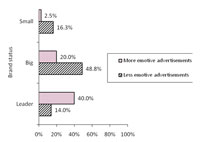A recent study by the Bureau of Market Research (BMR) at the University of South Africa (Unisa) found that television advertisements that evoke primary emotions (primary emotive reactions are essentially non-conscious pleasurable or repulsive states of arousal), are remembered more readily than less emotional advertisements.
According to Prof Pierre Joubert, research professor at the BMR, many people find it difficult to admit that they are not in full control of their decisions. This is especially the case for television advertising, where promoting an image or general perception, rather than functional attributes, is commonly used. The fact remains that emotions play a fundamental part in decision making.
These findings are evident from a recent BMR study that investigated the influence of emotions among approximately 200 television advertisements. Specific emotions that were largely present in 25 % of the most emotive advertisements included contentment (pleasure) and surprise (amazement, astonishment). According to Joubert, emotive television advertisements are likely to reflect a warm or caring, cute or adorable, happy or fun-loving, relaxed or comfortable, cool or laid back and conservative or traditional tone. Emotional advertisements were also associated with gentle, honest, relaxing, positive, warm, calming, and caring feelings.
The BMR study also revealed that emotive advertisements differed from less emotive advertisements by displaying lower levels of familiarity in the advertisements themselves. Viewers are therefore less likely to become accustomed to more emotive advertisements.
The BMR study also shows that emotive television advertisements tend to include more devices displaying scenic beauty, established brand cues, children, animals and vignettes, but fewer auditory devices with spoken taglines. Appeals and propositions that attempt to differentiate brands from competitors, or introduce new features or variants, are significantly more common in less emotive television advertisements, while social responsibility appeals are present in more emotive advertisements. Furthermore, emotive television advertisements also tend to use significantly more music linked to the main message to create an overall positive mood.
An intriguing finding from the study shows that there tends to be significantly fewer emotive advertisements for smaller brands.
Brand status in more emotive and less emotive advertisements:
Emotive advertisements also tend to show either the product or brand infrequently or at the end of the advertisement.
Finally, it was found that less emotive advertisements provide more intrinsic (e.g. product attribute) information than do more emotive advertisements.
The research is of specific interest to both advertising practitioners and researchers, providing a comprehensive overview of what constitutes emotive television advertising, as well as highlighting the crucial role emotions play in the advertising process.
- EMOTIONALITY IN TELEVISION ADVERTISEMENTS (Research Report no 373) was compiled by Prof Pierre Joubert (Professor: Bureau of Market Research). The report, consisting of 117 pages, focuses on the emotionality in television advertisements. The report is available from the Bureau of Market Research, PO Box 392, UNISA 0003.














































